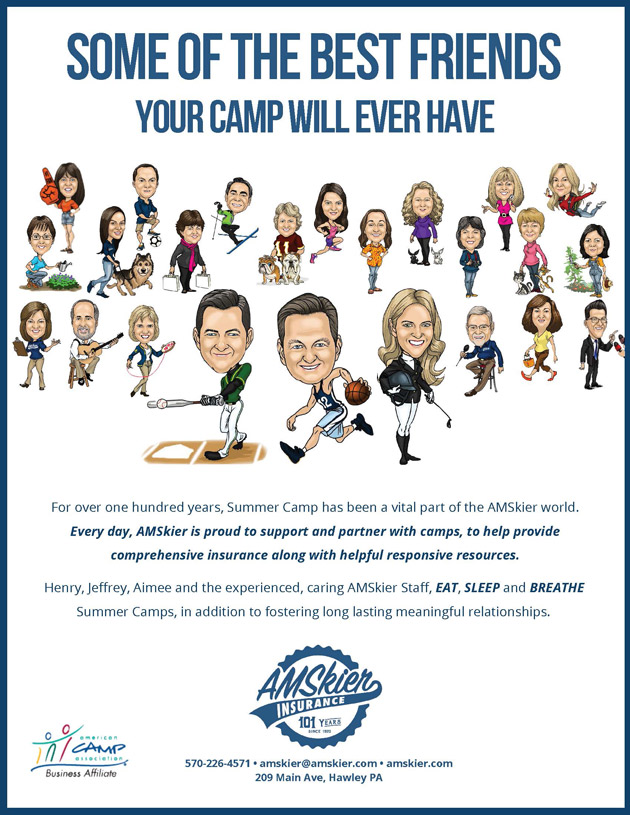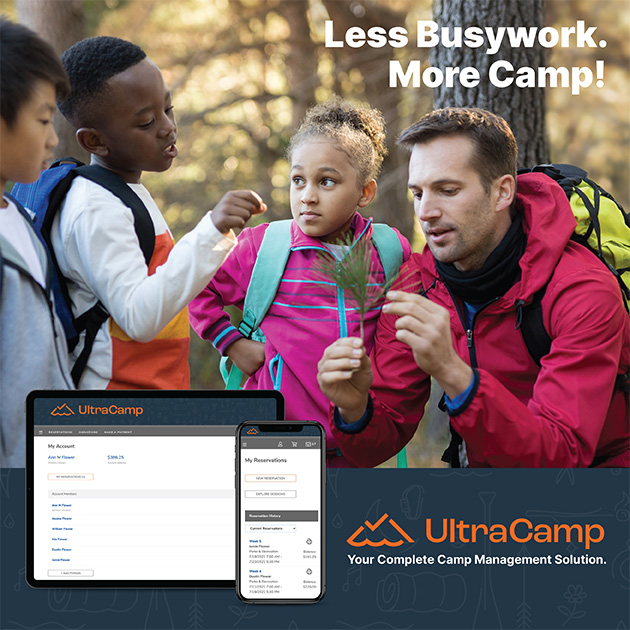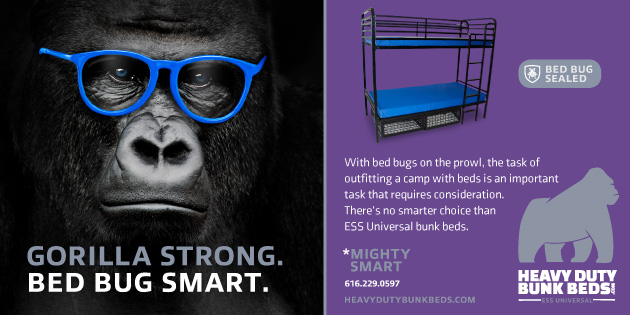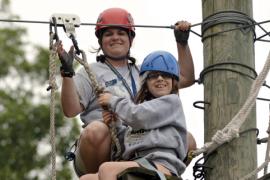Risk comes in many forms, some of which we spend more time considering and mitigating than others. On the “yeah, obviously” side of the ledger: we don’t allow campers on the ropes course without belay, we don’t swim without a lifeguard, and we don’t dismiss campers into the care of an adult without checking that person’s ID against the approved pick-up list.
These are risks we must manage once campers are participating in our programs. But what about the risk we assume when we accept campers into our programs? As one of the critical decision points that provides direction to the summer ahead, the enrollment process is fraught with hidden risks that must be properly evaluated to ensure they can be safely addressed.
Mission Impossible?
In the case of accepting a wide diversity of campers into our programs, avoiding the risk is, in many ways, burying our heads in the sand. While it prevents us from having to create additional supports and evaluate our programs and people for readiness, it does not help us achieve inclusivity.
Reframing slightly, we could say that by trying to avoid risk in the area of enrollment management, we are instead passively accepting risk; that is, we sort of “hope it won’t happen” and decide we’ll “cross that bridge when we come to it.” The challenge with this is that, in society, those bridges are collapsing all around us. It’s no longer possible — nor, many would argue, should it be possible — to simply fill our moat with alligators and hope the bridge keeps our enrollment squarely within our carefully defined boundaries. Therefore, if we try to avoid enrollment risk (or passively accept it), we could find that:
- We can’t actually avoid it.
- We aren’t prepared for it when it eventually happens anyway.
- Alligators are a terrible investment (who knew?).
So, should we just throw open the doors to all? While there are good arguments to do so (if we are set up for it) from the inclusion standpoint, a number of concerns on the risk management side of the aisle should give us pause. The idea that all participants, regardless of ability or disability, can experience programming together without barriers is not an inherent risk. However, passively assuming that our programs can provide safe experiences for everyone, regardless of need and without the appropriate supports in place, is a significant risk.
What are some ways we can mitigate and manage the risks that come with enrolling campers in our programs?
Use an Application
Consider using an application rather than a registration form. A parent filling out a registration form has every right to believe that by doing so they are registering their child for camp. That can make asking questions or getting further clarification about potential areas of challenge or need more difficult for you. And after reviewing the registration, if you feel that your program may not be the best fit for that child, you’re starting from a position of vulnerability; they’ve already enrolled. Now you find yourself potentially needing to remove them from the camp community — a move fraught with tension, negative publicity, and possibly even legal complications. Better to start with a pleasant conversation about whether your camp is a good match for the camper.
Asking for an application rather than allowing open registration may feel like you are passing judgment on which campers will be admitted into your program, and that doesn’t sit well with most of us as youth development professionals. However, other camps are out there, and one of them is a good fit for every child. We do ourselves — and the campers, staff, other camp operators, and families — a bigger disservice by blindly accepting all when we may not truly be prepared to manage all participants safely. And we open ourselves up to immense risk when we bring a child who we are not prepared to safely support into our camp community.
Ask Questions to Gather Key Information without Scaring off Parents
You can incorporate several easy questions into your camp application/enrollment process that will give you a “heads up” about whether a camper may need additional supports to successfully participate. You can ask about the ratio of students to teachers in the child’s classroom, whether or not they have any specific classroom supports like an Individualized Education Program or 504 plan (which ensures that no student with any sort of disability is discriminated against), or try one of my personal favorites: “When my child is in an activity led by one adult, they are best able to participate when there are no more than ____ other children in the group.”
If you don’t want to ask school or ratio-based questions, try something like, “At the end of their time at camp, what do you want your child to have accomplished?” The answers here will help you gain insight into the parents’ expectations and whether your program is set up to meet them or would need adjustments to do so. You can reasonably expect that most parents/guardians will reply with things like, “Kaylee wants to catch a fish in the lake!” or “Jacob is excited to be in the camp musical this year.” Your radar might go up with responses like “We would like Sam to practice social skills and build his social awareness” rather than the simple “Sam wants to make new friends.” And you might (rightfully) be quite concerned with the extra-honest parent who writes, “We just want Bailey to get through all the sessions we register for this time.” If the answers you receive give you pause, it’s a perfect time to call and have a chat with the parents to clarify lingering questions.
Don’t Wait until the “Due June 1” Health Form to Gather MESH Info
Part of lowering the risks surrounding camper participation is making sure we have the staff, supervision, protocols, and supports in place to ensure their safety while at camp. We certainly wouldn’t wait until June 1 to begin the process of hiring lifeguards or fixing broken equipment. Yet with less-obvious risks, such as accepting campers who may fall outside our typical population, we often unintentionally miss the chance to plan ahead.
According to the Centers for Disease Control and Prevention (CDC), almost 10 percent of children in the United States have diagnosed attention-deficit/hyperactivity disorder, 7.5 percent have diagnosed anxiety, and 7 percent have diagnosed behavior problems (CDC, 2021). Add to this the collective trauma of the ongoing pandemic, and the reality is that these mental, emotional, and social health (MESH) challenges are starting younger and younger — one in six youth ages two to eight have a diagnosed mental, behavioral, or developmental disorder (CDC, 2021). We should not be surprised, then, when applicants to our programs have additional needs. The earlier we receive details and data from families on MESH concerns, the more equipped we are to determine what methods of risk mitigation we may need to put in place.
Have a Documented Process for Evaluating Camper Applications
When reviewing registrations, we often look at geographical details (Will they have to fly unaccompanied to camp? Who will meet them?) or demographics such as age (Do we have space in that group this year?). Many of us have well-developed and carefully implemented processes for organizing waitlists or evaluating financial need. But how many of us have an equally structured or risk-focused system for evaluating camper fit?
There is no right or wrong way to evaluate fit for a certain camper, but good risk management indicates that in addition to determining how many weeks to enroll or which bus they are taking to camp each day, we should have a system that fairly evaluates all potential attendees in areas that are predictors for risk. Some examples of these are outlined in the following table:
Type of Risk |
Sample Questions for Determining Readiness/Ability to Mitigate and Manage Risk |
|
Safety Risk Physical safety is one of the most outwardly obvious types of risk. We should evaluate whether any individual camper presents a greater potential risk to the program than any other camper. If they do, we need to determine why and to what extent, and then decide if we are willing to accept that risk and/or if we have the ability to mitigate it to an acceptable level. |
|
|
MESH Risk MESH risks run the gamut from minor concerns about which a parent/guardian wants us to be aware to serious conditions that may significantly impact the ability of a child to successfully and safely participate in our program. MESH concerns are becoming more widespread, and camps are putting more focus on managing these issues in their communities, but it is still important to be honest with ourselves, the clients we serve, and the staff we hire about what we are able to safely manage at each step along the way toward optimal MESH management. |
|
|
Financial Risk Every camper space we fill has a direct impact on the budget. Depending on how tight the budget is, some programs may not have the financial flexibility to enroll campers whose uncertainty of fit could become a potential refund issue partway through the summer. |
|
|
Staff Risk We rely on our staff not only to be excellent role models, leaders, and supervisors, but also to still be at camp at the end of their contract. Accepting campers that stretch the boundaries of what staff are capable of handling, without putting matching supports in place, can cause staff stress to rise, morale to dip, and compassion fatigue to quickly set in — all of which seriously increase risk. |
|
|
PR/Reputation Risk A camp’s reputation and public perception is a core piece of its assets and should be considered just as at risk as any physical building or programmatic element. |
|
Some risks are certainly worth taking to ensure that our programs are able to reach and welcome as wide a group of participants as possible. Enrolling campers with an eye toward actively reducing those risks to an appropriate level is a key step in expanding inclusivity and, ultimately, in making camp opportunities safely available to all.
Photo courtesy of Camp Chewonki, Wiscasset, ME
Emily Golinsky, MS, provides training, consulting, and advocacy for camps, schools, and youth development organizations through her company Bright Moose LLC.
Reference
Centers for Disease Control and Prevention. (2021, March 22). Data and statistics on children’s mental health. Retrieved from cdc.gov/childrensmentalhealth/data.htm






